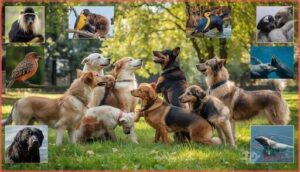This site is supported by our readers. We may earn a commission, at no cost to you, if you purchase through links.

You might catch your dog mounting another of the same sex at the park and wonder what’s really going on in that furry head. Despite what you’ve heard, same-sex behavior isn’t rare or mysterious in dogs—it’s woven into the social fabric of canine life.
Mounting, licking, and even close following between dogs of the same sex show up in households and playgroups everywhere. The science behind these behaviors reveals a complex mix of hormones, social dynamics, and evolutionary quirks.
Understanding whether dogs can be gay means looking past human labels and seeing what motivates their actions.
Table Of Contents
- Key Takeaways
- Can Dogs Be Gay?
- What is Same-Sex Behavior in Dogs?
- Why Do Dogs Mount Other Dogs?
- How Common is Same-Sex Behavior in Animals?
- What Causes Same-Sex Behavior in Dogs?
- Do Dogs Have a Sexual Orientation?
- Should You Be Concerned About Same-Sex Behavior?
- Frequently Asked Questions (FAQs)
- Can a male dog be attracted to another male?
- Can animals be gay, yes or no?
- Can two male dogs be together?
- Can male dogs like male dogs?
- Are there any evolutionary advantages to same-sex behavior in animals?
- Is there a difference between sexual behavior and sexual attraction in animals?
- What are the signs of a dog having a sexual preference?
- How can I stop my dog’s unwanted humping behavior?
- Do female dogs exhibit same-sex mounting behaviors?
- Can spaying affect same-sex behavioral patterns?
- Conclusion
Key Takeaways
- Same-sex behaviors like mounting and licking are common in dogs and usually reflect social bonding, play, or stress rather than sexual orientation.
- Dogs don’t have fixed sexual preferences or identities like humans; their actions are shaped by hormones, context, and learned behaviors.
- Mounting can signal play, dominance, or anxiety, and rarely indicates exclusive attraction to the same sex.
- Labeling dogs as “gay” is misleading, since their behavior is fluid and driven by social and biological factors, not personal identity.
Can Dogs Be Gay?
Can dogs be gay? It’s a question many dog owners have asked after watching their pup enthusiastically mount a same-sex companion. The short answer is that we don’t have scientific evidence that dogs possess sexual orientation in the way humans do. While same-sex behavior in dogs—mounting, licking, and courtship-like actions—is common and well-documented, these behaviors don’t necessarily indicate a fixed preference or canine orientation.
Dogs exhibit what scientists call sexual fluidity, engaging in behaviors with both sexes depending on context, arousal, and social circumstances. Hormonal influence plays a role, particularly in intact dogs, but so do play, stress, and social bonding. About 78% of animal behavior specialists have observed same-sex sexual behavior in their subjects, yet most animals displaying these behaviors are considered bisexual rather than exclusively homosexual. Dog bisexuality, or more accurately, sociosexual behavior without rigid orientation, appears to be the norm rather than the exception. Understanding same sex relationships can provide valuable insights into canine behavior and social dynamics.
What is Same-Sex Behavior in Dogs?
When dogs engage in mounting, licking, or other behaviors with same-sex companions, it can look a lot like sexual activity—but appearances don’t always tell the full story. These behaviors show up in both male and female dogs, neutered or intact, and they serve a surprising variety of purposes beyond reproduction.
Let’s break down what same-sex behavior actually looks like in dogs, how to tell when it’s sexual versus social, and what examples reveal about how differently males and females express these behaviors.
Common Same-Sex Behaviors Observed
You’ll notice same-sex sexual behavior in dogs takes several forms beyond simple mounting. Male and female dogs engage in mounting, thrusting, licking, and close following with same-sex partners—behaviors that appear in both intact and neutered animals.
These canine social bonds serve multiple purposes, from stress relief to establishing social hierarchy, making same-sex interactions a normal part of dog communication rather than purely reproductive activity. Sometimes, this behavior can be related to same sex aggression.
Differences Between Sexual and Social Behaviors
Figuring out whether your dog’s mounting is about sex or just social shenanigans comes down to contextual factors. Sexually motivated mounting usually involves an erection, persistent thrusting, and focused partner preference—especially when females are in heat. Social behavior, on the other hand, pops up during play with loose body language and quick role reversals, regardless of arousal levels or reproductive status.
Key signs that distinguish sexual from social mounting:
- Behavior intensity: Sexual mounting persists despite redirection; play mounting stops when partners separate
- Arousal levels: Genital arousal and focused attention signal sexual motivation; relaxed faces indicate social interaction
- Partner preference: Sexually driven dogs target specific individuals repeatedly; social mounters engage with various playmates
- Post-behavior actions: Sexual sequences may include courtship-like following; play mounting transitions quickly to chasing or wrestling
- Environmental context: Sexual behavior emerges in low-distraction settings; social mounting spikes during high-energy group play in novel environments like dog parks
Examples in Male and Female Dogs
Male dogs show mounting in 25% of intact park encounters, often accompanied by genital licking and weaving around preferred partners. Female dog behavior mirrors this at 17% frequency, with mounting during heat cycles or excitement.
Same-sex play includes courtship-like following, persistent sniffing, and reciprocal mounting—regardless of whether you’ve got male or female dogs.
These canine sexual behavior patterns surface as early as five weeks old.
Why Do Dogs Mount Other Dogs?
If you’ve ever watched your dog hump another dog of the same sex, you probably wondered what was going through their mind. The truth is, mounting behavior isn’t always about sex—it can mean a lot of different things depending on the situation.
Let’s break down the main reasons dogs mount each other, so you can better understand what’s really happening.
Sexual Motivation Vs. Play
How can you tell if mounting is sexually motivated or just playful? Sexual cues include flirtatious body language—tail up, ears back, licking, and pawing. Intact males may even ejaculate during mounting, while neutered males can still display erections.
In contrast, play behavior emerges as early as five weeks old, lacks genital responses, and occurs during general excitement without the telltale signs of canine sexual behavior or reproductive interest.
Dominance and Social Hierarchy
Pack dynamics shape much of what we see in canine behavior. Mounting can serve as a dominance signal within the social hierarchy, where one dog asserts status over another.
Studies of free-ranging groups show that higher-ranking individuals mount subordinates more frequently, often alongside other hierarchy-formation behaviors like controlling resources. Status negotiation through mounting helps dogs establish and maintain their social position without escalating to serious aggression.
Stress, Anxiety, and Overstimulation
When dogs feel overwhelmed, mounting can become a stress response—a way to release pent-up tension. Around 72.5% of dogs show anxiety-related behaviors, and overstimulation from noise, new environments, or disrupted routines often triggers mounting.
- Excessive barking, restlessness, and hyperactivity signal overstimulation signs
- Chronic stress can lead to repetitive behaviors and aggression
- Calming techniques like predictable routines support stress management and anxiety relief
How Common is Same-Sex Behavior in Animals?
If you think your dog might be the only one engaging in same-sex behavior, think again. This pattern shows up throughout the animal kingdom, from primates to birds to marine mammals.
Let’s look at just how widespread this behavior really is, what it means for dogs specifically, and how some species even form lasting same-sex partnerships.
Prevalence Across Animal Species
You might be surprised to learn that same-sex behavior in animals isn’t rare—it’s widespread across the animal kingdom. Scientists have documented this behavior in over 1,500 species, from mammals to birds to insects.
In fact, about 78% of animal experts have witnessed homosexuality in animals they study, revealing behavioral patterns with deep evolutionary roots shaped by species diversity and social learning.
Documented Cases in Dogs and Other Animals
Looking at real-world examples, male giraffes engage in mounting up to 94% of incidents—far more than heterosexual coupling. European polecats display exclusive homosexuality with mounting and anal penetration. Grey-headed flying foxes show mutual grooming with erect penises commonly observed in males.
In dogs, you’ll find cases like a 4-year-old castrated Border Collie whose canine preputial scent attracted intact males for mating attempts. Puppy play involving same-sex mounting starts around five weeks old.
Same-Sex Pair Bonding and Parenting
Beyond fleeting encounters, some animals form lasting same-sex relationships that rival any partnership. Laysan albatross pairs—over 30% female duos—cooperatively parent chicks for years. Swans and penguins raise orphaned young together, strengthening social bonds in animals through mutual care.
In dogs, you’ll notice:
- Affectionate licking between bonded pairs
- Selective companionship that bolsters pack stability
- Cooperative behaviors enhancing mutual well-being
- Long-term pair bonds strengthening canine interactions
These social functions thrive especially where limited access to opposite-sex partners exists.
What Causes Same-Sex Behavior in Dogs?
Same-sex behavior in dogs isn’t driven by a single cause—it’s actually a mix of biology, social dynamics, and evolutionary quirks. Hormones play a role, but so do play, bonding, and even ancient survival strategies that scientists are still puzzling over.
Let’s break down the main factors that shape this behavior.
Hormonal Influences and Sexual Maturity
Around puberty onset, your dog’s body goes through hormone surges that reshape behavior. Most pups hit sexual maturity between six and twelve months, when testosterone or estrogen levels climb sharply. Even after neutering effects reduce circulating hormones, mounting can persist—proof that learned patterns matter as much as biology. Of note, dimorphism persistence means some sex-specific traits stick around long after spay or neuter, influencing how your dog interacts with others throughout life.
| Life Stage | Key Hormones | Typical Behavioral Changes |
|---|---|---|
| Pre-Puberty (0–5 months) | Low testosterone/estrogen | Minimal sexual interest or mounting |
| Early Puberty (5–7 months) | Rising testosterone (males), estrogen (females) | Emergence of mounting, genital focus |
| Sexual Maturity (6–15 months) | Peak sex steroids | Increased mating behaviors, territorial marking |
| Post-Neuter | Reduced testosterone/estrogen | Persistence of learned mounting, less hormone-driven arousal |
Breeding cycles in intact females trigger spikes in progesterone and estrogen, which can heighten mounting behavior in nearby males—and sometimes females—regardless of the target’s sex. That’s why hormonal influence doesn’t tell the whole story: context, excitement, and prior experience all shape canine sexuality in ways that go beyond simple reproductive drives.
Social Bonding and Play
Play is where your dog learns the social ropes. Rough-and-tumble wrestling, play bows, and contact licking all strengthen bonds between pups, regardless of sex.
Studies show these affiliative play behaviors help synchronize dog social interactions, reduce tension, and clarify social hierarchy without real conflict.
When your dog mounts a same-sex buddy during a chase game, it’s often canine play—not romance—building trust and group cohesion.
Evolutionary Theories and Scientific Perspectives
Scientists see same-sex sexual behavior in dogs as an evolutionary byproduct of domestication. When wolves became dogs, they developed stronger social bonding instincts and retained playful behaviors into adulthood.
Research shows same-sex mounting often strengthens alliances and reduces aggression in group-living species.
Unlike humans, dogs don’t have fixed sexual orientation—their behavior reflects hormonal influences, social context, and evolutionary functions rather than romantic preference.
Do Dogs Have a Sexual Orientation?
Here’s the thing: dogs don’t experience sexuality the way humans do. While we might wonder if a dog mounting another male or showing preference is “gay,” scientists warn against slapping human labels on animal behavior.
Dogs don’t experience sexuality like humans, so scientists caution against using human labels such as “gay” for their behavior
Let’s look at what actually separates canine mating patterns from human sexual orientation.
Differences Between Animal and Human Sexuality
When you think about sexual orientation in humans, you’re really talking about identity constructs—how people see themselves. Dogs don’t have that internal narrative.
While hormonal experiments and evolutionary models help us understand animal sexuality, measurement methods for dog sexuality focus purely on observable sexual behavior and social functions. Researchers warn against anthropomorphism: projecting human-style orientation onto species that simply don’t experience it that way.
Scientific Caution Around Labels
Labeling dogs as “gay” trips over anthropomorphism risks that experts have flagged for years. When you apply human terms to animal behavior, you’re implying an internal identity that researchers simply can’t verify.
Most specialists agree: evidence gaps make orientation labels misleading. Instead, focus on what’s observable—same-sex behavior driven by context, not identity. That’s the consensus across veterinary and ethology fields.
Occurrence of Exclusive Same-Sex Preference
True exclusive same-sex attraction—where dogs consistently choose same-sex partners over opposite-sex mates—hasn’t been documented the way it has in roughly 8% of rams. Methodological challenges make prevalence estimates elusive:
- Dogs lack controlled partner-preference studies comparing hormonal influence and lifelong choices
- Same-sex mounting often reflects play or dominance, not orientation
- Most same-sex sexual behavior is opportunistic rather than exclusive
- Can dogs be gay? Evidence for enduring homosexual behavior remains anecdotal, not systematic
Should You Be Concerned About Same-Sex Behavior?
Most of the time, same-sex mounting in dogs isn’t something you need to worry about. It’s part of how dogs play, communicate, and work out their social dynamics.
That said, there are situations where the behavior crosses from normal to problematic, and knowing the difference helps you support your dog’s health and happiness.
When Mounting is Normal or Problematic
Ever notice your dog humping the couch after a walk? Mounting behavior in dogs is often just excitement or social play, not a sign of sexual gratification or dominance. Mounting frequency peaks in young dogs and can reflect normal contexts like play or greeting.
Problematic indicators—stress, anxiety, or medical contributions—show up when dog humping behavior becomes frequent, intense, or disruptive.
Addressing Excessive or Inappropriate Behavior
Is your dog’s humping starting to feel like a circus act gone rogue? Addressing excessive dog humping behavior begins with a veterinary assessment to rule out medical issues.
Combine clear training techniques—like “leave it”—with energy diversion, immediate interventions, and professional support if needed.
These steps are key in managing dog behavior problems and preventing escalation into dog aggression or persistent dog training challenges.
Promoting Healthy Socialization and Well-Being
Want your pup to thrive? Social playgroups, early socialization, and plenty of human-dog interaction are your secret weapons for preventing loneliness and boosting dog health and wellbeing.
Environmental enrichment—think toys, varied activities, and safe spaces—keeps social dynamics positive. When you weave these into daily life, you’re not just training behavior; you’re shaping lifelong pet wellbeing and confidence.
Frequently Asked Questions (FAQs)
Can a male dog be attracted to another male?
Like two pals sharing secrets at a fence, male dogs may show affection or sexual signals toward other males.
Same-sex behavior in dogs, including mounting, reflects canine bisexuality, dog preferences, and sometimes playful or social motivations.
Can animals be gay, yes or no?
Yes, animals can exhibit same-sex sexual behavior—documented in over 1,500 species. However, scientists caution against labeling animals “gay,” since that implies human-like sexual orientation, which most animals don’t consistently demonstrate.
Can two male dogs be together?
Absolutely—male dog bonds form naturally through canine companions and healthy dog socialization. Same-sex interactions don’t reflect dog sexuality or homosexual behavior myths; they’re normal friendships. Male dogs thrive together with proper introductions and compatible personalities.
Can male dogs like male dogs?
Male dogs can certainly like other male dogs—forming strong social bonds through play, grooming, and companionship.
While male dog attraction includes mounting and courtship-like behaviors, these actions reflect canine social bonds rather than human-style sexual orientation.
Are there any evolutionary advantages to same-sex behavior in animals?
Same-sex sexual behavior in animals often helps reduce aggression, strengthen social bonds, and improve group cohesion.
These benefits can boost survival and resource access, making homosexuality in animals and sexual orientation in animals adaptive parts of animal behavior.
Is there a difference between sexual behavior and sexual attraction in animals?
Think of animal sexual behavior as the dance, and sexual attraction as choosing a partner for the music. Behavior vs. Attraction matters—mounting, for example, may reflect play, dominance, or hormonal influence, not consistent partner preference or sexual orientation.
What are the signs of a dog having a sexual preference?
You might notice preference indicators like partner consistency, arousal cues, and repeated mating rituals with certain dogs. Exclusive behavior—showing sexual interest only in same-sex partners—is rare in dog sexuality, making sexual preference tough to pin down.
How can I stop my dog’s unwanted humping behavior?
Your dog’s humping behavior isn’t about dominance—it’s often excitement or stress. Redirect with training techniques like “sit,” provide daily exercise, and consult your vet about medical causes or neutering effects if it persists.
Do female dogs exhibit same-sex mounting behaviors?
Yes, female dogs commonly mount other females. This behavior is primarily social—linked to dominance displays, hormonal influence, stress relief, or play—rather than sexual attraction.
Aggression triggers and temperament factors also contribute to this mounting pattern.
Can spaying affect same-sex behavioral patterns?
Spaying effects go beyond just reducing sexual behavior—hormonal influence can lower mounting and humping in neutered dogs by over 50%, but learned same-sex behavior and aggression shifts may persist, leading to noticeable social impacts and behavior changes.
Conclusion
Think of canine sexuality as a patchwork quilt—stitched from play, hormones, and instinct, with patterns that don’t always match our expectations. Asking “can dogs be gay” is like trying to label a cloud; the shapes are real, but the boundaries blur.
What matters most is understanding your dog’s behavior without judgment or worry. Embrace the quirks, guide when needed, and let curiosity lead. In the end, dogs thrive when we accept their social tapestry as it is.
- https://petcorner.pangovet.com/pet-behavior/cats/gay-lesbian-bisexual-cats/
- https://www.youtube.com/watch?v=Ij-AQIw4bl8
- https://www.nature.com/articles/s41467-023-41290-x
- https://www.vetmed.ucdavis.edu/sites/g/files/dgvnsk491/files/inline-files/Inappropriate_Mounting_in_Dogs.pdf
- https://www.aspca.org/pet-care/dog-care/common-dog-behavior-issues/mounting-and-masturbation















